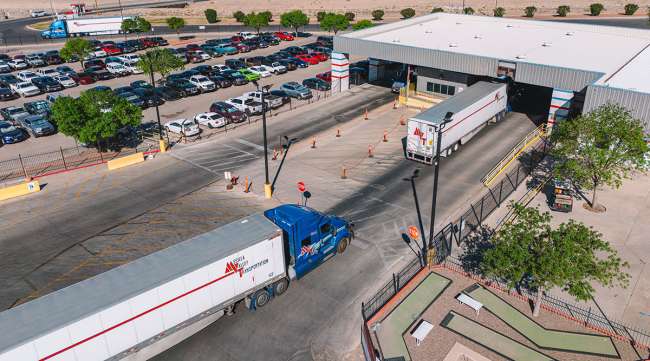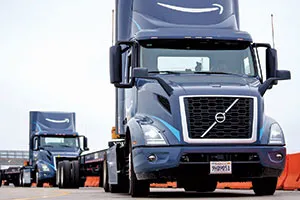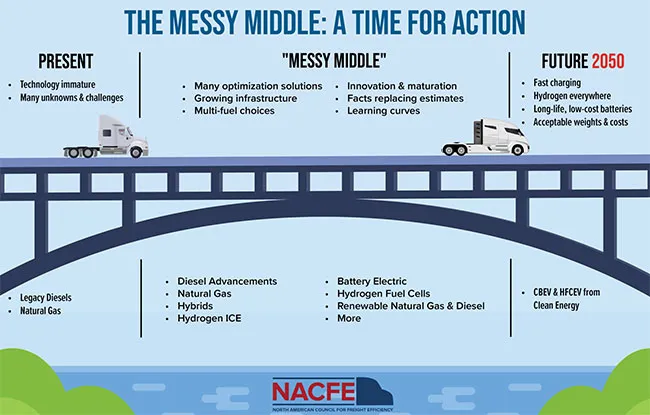Special to Transport Topics
Private Fleets Pursuing Emissions Goals More Aggressively

[Stay on top of transportation news: Get TTNews in your inbox.]
Across all areas of the economy, shippers are facing increasing pressure to make their operations more sustainable and to meet environmental, sustainability and governance (ESG) targets.
These standards are either set by corporate leadership — for instance, Coca-Cola’s target to reduce greenhouse gas emissions 25% over 15 years and to be carbon neutral by 2050 — or federal regulations, such as the new federal rules requiring public companies to report their emissions to the U.S. Securities and Exchange Commission. That has some companies looking to exercise greater control over GHG emissions in their logistics networks by stepping back from for-hire carriers and increasing their private fleets.
Mike Roeth, executive director of the North American Council for Fuel Efficiency, used Amazon as an example of a company looking to garner more control over its operations and conversely, carbon emissions.
“Amazon’s becoming their own fleet, not hiring people to move their goods,” he said.
RELATED: EPA Sets Strict Emissions Standards for Heavy Trucks
According to Amazon’s most recent yearly corporate sustainability report, its ESG goals are a reason for that move. Direct emissions from the company’s delivery fleet account for nearly 20% of Amazon’s overall environmental releases. In 2022, the company reported an increase in company emissions due to moving shipping from third-party carriers to Amazon Logistics.

Amazon recently made plans to deploy 47 Volvo VNR Electric tractors across its Southern California operations in an effort to decarbonize its fleet. (Amazon)
Amazon ranks No. 1 on both the Transport Topics Top 100 largest logistics companies in North America and TT Top 50 global freight companies lists and No. 9 on the TT Top 100 private carriers list.
“Trucking is a challenging area to decarbonize, particularly considering longhaul distances and the requirements for high-power EV charging infrastructure across transportation routes. There is currently no single solution that can be scaled for decarbonizing middle-mile trucking,” the company stated in the report, adding that it is pursuing several different technologies, including battery-electric vehicles, renewable natural gas and hydrogen fuel cells.
RELATED: Amazon Chooses Volvo VNR Electric as First Class 8 BET in US
“We are making great progress in reducing transportation emissions where opportunities exist, such as by investing in electric delivery vehicles,” the company reported. The company reports delivering 145 million packages in the U.S. and Europe with its fleet of 9,000 electric vehicles, and it is testing electric heavy goods vehicles — weighing up to 40 metric tons — in the U.K. and Germany.

Jones
Major retailers, food and beverage companies, and home improvement stores are starting to aggressively pursue environmental goals, with some starting to expand their private fleets to meet those goals. Royal Jones, president and CEO of Mesilla Valley Transportation and MVT Solutions, said his companies have helped private fleets find fuel efficiencies in their operations. “We do a lot of testing through MVT Solutions … to help them get greener,” Jones explained. “We are hearing that they’re buying more trucks because they can’t seem to find [carriers] working towards that. But the truth is, there’s a disconnect.”
Mesilla Valley Transportation ranks No. 72 on the TT Top 100 list of the largest for-hire carriers.
Daryl Bear, lead engineer and chief operating officer for MVT Solutions, noted that sustainability goals are more than just a trend. They are becoming the standard.
“It’s huge financially, it’s huge environmentally, and now with the private companies and their massive sustainability agendas, it’s really coming to the surface,” he said, adding that shippers are working toward carbon-neutral goals, and carriers need to be at the forefront of that effort, or they risk losing business.
Corey Cox of the Tandet Group of companies discusses how early AI adopters are beginning to harvest the latest wave. Tune in above or by going to RoadSigns.ttnews.com.
MVT Solutions offers a “Real-World Fuel Savings Analysis” report that looks for fuel savings in fleets’ operations. The company also has done extensive testing on many different products on the market that can help fuel efficiency. He said that anecdotally, he has heard of instances in which major shippers are making the move — or at least considering — to bring fleet operations in-house to meet sustainability goals faster.
“It surprised me,” Bear said. “The for-hire fleets are generally pretty aggressive about changing to meet what their customer needs.”
His position, he said, forces him to look at the issue from multiple perspectives — from the viewpoint of the shippers and private fleets but also from the viewpoint of the for-hire fleets.
In conversations with private companies, Bear noted that the focus is on the incentives that are in place for for-hire carriers to meet sustainability goals, such as higher rates per mile or more business opportunities for meeting certain benchmarks. Bear said he’s finding that in many cases, carriers are unsure on what exactly needs to be done to meet goals and get tendered for the jobs. While his company has become adept at measuring miles-per-gallon costs, Bear contended that there doesn’t seem to be a standard for measuring sustainability factors.

Roeth
NACFE’s Roeth said sustainability is at the forefront of most conversations — starting at the driver level.
“The first question in employee meetings, even in driver meetings is ‘What are we doing as a company to be more sustainable?’ he explained, adding that fleets are working hard to meet sustainability goals, both their own and those of their clients.
“Carriers are making sustainability commitments,” Roeth said. “It’s not just the fuel savings, but they’re also wanting to meet their own ESG goals. I don’t get shocked too often, but it shocks me that they have leaned in so much.”
Roeth said one of the first things that shippers look to when trying to meet a zero-emission goal is zero-emission trucks — often battery-electric operated. What isn’t apparent at the first glance to most shippers, he warned, is just how costly of a move that can be.
“They’re going into it kind of believing that it’s not that expensive,” Roeth said, adding that it’s a “fairly erroneous expectation” by shippers to buy into zero-emission freight movement at little to no cost increase.

NACFE’s illustration of the path of fuel efficiency labeled as “The Messy Middle.” (NACFE)
NACFE supports development and deployment of battery-electric vehicles — but he notes the technology is developing and isn’t yet appropriate to all lanes. However, he sees carriers and shippers collaborating to make it work — identifying routes between distribution centers, within the range of a single charge on an electric truck, for example. Under current technology, the distribution centers must be within an electric truck’s range at full charge; and the distribution centers must have facilities where the trucks can sit and be offloaded while recharging.
“I think there’s a misunderstanding on what these trucks can do right now. I’m a big believer in electric trucks, and I think they do a great job in certain segments of the market right now,” Roeth said. He noted that smaller trucks with shorter delivery times and miles per day are areas where these trucks are scaling right now.
When looking to find ways to reduce carbon emissions, MVT’s Jones noted that every gallon of diesel fuel puts 22.35 pounds of carbon into the air. MVT then looks at ways to decrease that and become more fuel efficient. The company then goes a step further and uses a higher blend of biodiesel than most American trucks. Burning biodiesel results in significantly less carbon emissions.
“If I were to get 20%, 30% better fuel mileage than my peers, and then I top it with B 30 (a 30% biodiesel blend), I’m putting 50 to 60% less stuff in the air than the average guy,” Jones said.
Short of switching to biodiesel, Bear said fleets can upgrade their trucks.
“Diesel engines are much more efficient, much more reliable now, and they get better every year,” he said. “A very significant way for fleets to improve fuel economy is simply by buying newer equipment.”

Oliver
Optimizing operations is another way to increase fuel economy and drive down emissions, according to Chris Oliver, chief marketing officer for Trucker Path. Using navigation apps can help drivers make sure they are following the most efficient, and safe, route.
“Drivers can spend nearly an hour a day driving around looking for a legal/safe parking spot, which wastes time, fuel and productivity,” Oliver wrote in an email, noting that telematics technology can identify truck and driver performance issues that decrease fuel efficiency. Not only can this help with fuel economy, but it can increase safety for the carrier, he said.
By focusing on fuel efficiency, large shippers and for-hire carriers can maximize sustainability efforts without making significant shifts to alternative fuels or similar options.
Want more news? Listen to today's daily briefing above or go here for more info
“The easiest way for us to all be more sustainable is obviously to burn less fuel. I mean, you can talk all you want about going electric, but electric over the road is a long way off,” Jones said, adding that reducing the fuel consumption average across his fleet by one-tenth of a mile resulted in savings of 26,000 gallons a month.
“Imagine if you were somebody who has more than 10 times more trucks than I do and that becomes hundreds of thousands of gallons, loads of fuel that just doesn’t have to be processed or burned or put into the air,” Jones said. “I care about our air, and I care about our future for our kids and grandkids, but we also want to save money by getting better fuel mileage.”





